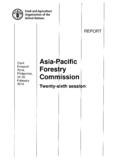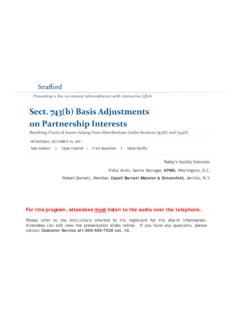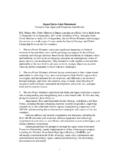Transcription of TRANS-PACIFIC PARTNERSHIP - …
1 This Document Contains TPP CONFIDENTIAL InformationMODIFIED HANDLING AUTHORIZED*COVER PAGETRANS- pacific PARTNERSHIPINTELLECTUAL PROPERTY RIGHTS CHAPTERDRAFT FEBRUARY 10, 2011 Derived From: classification Guidance dated March 4, 2010 Reason: (b)Declassify on: Four years from entry into force of the TPP agreement or, if no agreement enters into force, four years from the close of the negotiations.* This document must be protected from unauthorized disclosure, but may be mailed or transmitted over unclassified e-mail or fax, discussed over unsecured phone lines, and stored on unclassified computer systems. It must be stored in a locked or secured building, room, or Document Contains TPP CONFIDENTIAL InformationMODIFIED HANDLING AUTHORIZED* CHAPTER [ ]INTELLECTUAL PROPERTY RIGHTSARTICLE 1:GENERAL Party shall, at a minimum, give effect to this Agreements to Article 1, the Parties affirm their existing rights and obligations with respect to each other under the TRIPS Agreement.
2 Party shall ratify or accede to the following agreements by the date of entry into force of this Agreement:(a) Patent Cooperation Treaty (1970), as amended in 1979;(b) Paris Convention for the Protection of Industrial Property (1967);(c)Berne Convention for the Protection of Literary and Artistic Works (1971); (d) Convention Relating to the Distribution of Programme-Carrying Signals Transmitted by Satellite (1974);(e) Protocol Relating to the Madrid Agreement Concerning the International Registration of Marks (1989);(f) Budapest Treaty on the International Recognition of the Deposit of Microorganisms for the Purposes of Patent Procedure (1977), as amended in 1980;(g) International Convention for the Protection of New Varieties of Plants (1991) (UPOV Convention); (h)Singapore Treaty on the Law of Trademarks (2006); (i) WIPO Copyright Treaty (1996); and (j) WIPO Performances and Phonograms Treaty (1996).
3 4. Each Party shall notify the WTO of its acceptance of the Protocol amending the TRIPS Agreement done at Geneva on December 6, Document Contains TPP CONFIDENTIAL InformationMODIFIED HANDLING AUTHORIZED* Party shall make all reasonable efforts ratify or accede to the following agreements by the date of entry into force of the Agreement:(a)Patent Law Treaty (2000); and(b)Hague Agreement Concerning the International Registration of Industrial Designs (1999).3 This Document Contains TPP CONFIDENTIAL InformationMODIFIED HANDLING AUTHORIZED* More Extensive Protection and Enforcement4 This Document Contains TPP CONFIDENTIAL InformationMODIFIED HANDLING AUTHORIZED* Party may provide more extensive protection for, and enforcement of, intellectual property rights under its law than this Chapter requires, provided that the more extensive protection does not contravene this respect of all categories of intellectual property covered in this Chapter, each Party shall accord to nationals1 of the other Parties treatment no less favorable than it accords to its own nationals with regard to the protection2 and enjoyment of such intellectual property rights and any benefits derived from such rights.
4 Party may derogate from paragraph [7] in relation to its judicial and administrative procedures, including requiring a national of the other Party to designate an address for service of process in its territory, or to appoint an agent in its territory, provided that such derogation is: (a)necessary to secure compliance with laws and regulations that are not inconsistent with this Chapter; and(b)not applied in a manner that would constitute a disguised restriction on trade. [7] does not apply to procedures provided in multilateral agreements to which any Party is a party and which were concluded under the auspices of the World Intellectual Property Organization (WIPO) in relation to the acquisition or maintenance of intellectual property rights. Application of Agreement to Existing Subject Matter and Prior Acts1 [For purposes of Articles [___(NT & Judicial/Admin Procedures)___(GIs/Nationals), and ___ (Performers/Phonograms/Related Rights,] a national of a Party shall also mean, in respect of the relevant right, an entity of that Party that would meet the criteria for eligibility for protection provided for in the agreements listed in [Article ] and the TRIPS Agreement.)]
5 ]2 [For purposes of this paragraph, protection includes matters affecting the availability, acquisition, scope, maintenance, and enforcement of intellectual property rights as well as matters affecting the use of intellectual property rights specifically covered by this Chapter. Further, for purposes of this paragraph, protection also includes the prohibition on circumvention of effective technological measures set out in Article and the rights and obligations concerning rights management information set out in Article ]5 This Document Contains TPP CONFIDENTIAL InformationMODIFIED HANDLING AUTHORIZED* as it otherwise provides, including in Article __ (Berne 18/TRIPS ), this Chapter gives rise to obligations in respect of all subject matter existing at the date of entry into force of this Agreement that is protected on that date in the territory of the Party where protection is claimed, or that meets or comes subsequently to meet the criteria for protection under this as otherwise provided in this Chapter, including Article ___ (Berne 18/TRIPS )
6 , a Party shall not be required to restore protection to subject matter that on the date of entry into force of this Agreement has fallen into the public domain in its territory. Chapter does not give rise to obligations in respect of acts that occurred before the date of entry into force of this Agreement. to Article ___ (Publication), and with the object of making the protection and enforcement of intellectual property rights transparent, each Party shall ensure that all laws, regulations, and publicly available procedures concerning the protection or enforcement of intellectual property rights are in writing and are published,3 or where publication is not practicable, made publicly available, in a national language in such a manner as to enable governments and right holders to become acquainted with them. ARTICLE 2:TRADEMARKS, INCLUDING GEOGRAPHICAL Party may require, as a condition of registration, that a sign be visually perceptible, nor may a Party deny registration of a trademark solely on the grounds that the sign of which it is composed is a sound or a Party shall provide that trademarks shall include certification marks.
7 Each Party shall also provide that geographical indications are eligible for protection as A Party may satisfy requirement for publication by making the law, regulation, or procedure available to the public on the For purposes of this Chapter, geographical indications means indications that identify a good as originating in the territory of a Party, or a region or locality in that territory, where a given quality, reputation, or other characteristic of the good is essentially attributable to its geographical origin. Any sign or combination of signs (such as words, including geographical and personal names, as well as letters, numerals, figurative elements, and colors, including single colors), in any form whatsoever, shall be eligible to be a geographical indication. The term originating in this chapter does not have the meaning ascribed to that term in Article (Definitions).
8 6 This Document Contains TPP CONFIDENTIAL InformationMODIFIED HANDLING AUTHORIZED* Party shall ensure that its measures mandating the use of the term customary in common language as the common name for a good or service ( common name ) including, inter alia, requirements concerning the relative size, placement or style of use of the trademark in relation to the common name, do not impair the use or effectiveness of trademarks used in relation to such good or service. Party shall provide that the owner of a registered trademark shall have the exclusive right to prevent all third parties not having the owner s consent from using in the course of trade identical or similar signs, including geographical indications, for goods or services that are related to those goods or services in respect of which the owner's trademark is registered, where such use would result in a likelihood of confusion.
9 In the case of the use of an identical sign, including a geographical indication, for identical goods or services, a likelihood of confusion shall be Party may provide limited exceptions to the rights conferred by a trademark, such as fair use of descriptive terms, provided that such exceptions take account of the legitimate interest of the owner of the trademark and of third parties. Party may require as a condition for determining that a mark is a well-known mark that the mark has been registered in the Party or in another jurisdiction. Additionally, no Party may deny remedies or relief with respect to well-known marks based solely on the lack of: (a) a registration; (b) inclusion on a list of well-known marks; or (c)prior recognition of the mark as Article 6bis of the Paris Convention for the Protection of Industrial Property (1967) shall apply, mutatis mutandis, to goods or services that are not identical or similar to those identified by a well-known trademark,5 whether registered or not, provided that use of that trademark in relation to those goods or services would indicate a connection between those goods or services and the owner of the trademark, and provided that the interests of the owner of the trademark are likely to be damaged by such Party shall provide for appropriate measures to refuse or cancel the registration and prohibit the use of a trademark or geographical indication that is identical or similar to a well-known trademark, for related goods or services, if the use of that trademark or geographical indication is likely to cause confusion, or to cause mistake.
10 Or to deceive or risk associating the trademark or geographical indication with the owner of the well-known trademark, or constitutes unfair exploitation of the reputation of the well-known For purposes of determining whether a mark is well-known, no Party shall require that the reputation of the trademark extend beyond the sector of the public that normally deals with the relevant goods or services. 7 This Document Contains TPP CONFIDENTIAL InformationMODIFIED HANDLING AUTHORIZED* 9. Each Party shall provide a system for the registration of trademarks, which shall include:(a)a requirement to provide to the applicant a communication in writing, which may be provided electronically, of the reasons for a refusal to register a trademark;(b)an opportunity for the applicant to respond to communications from the competent authorities, to contest an initial refusal, and to appeal judicially a final refusal to register;(c)an opportunity for interested parties to oppose a trademark application and to seek cancellation of a trademark registration after it has been granted; and(d)a requirement that decisions in opposition and cancellation proceedings be reasoned and in writing.




